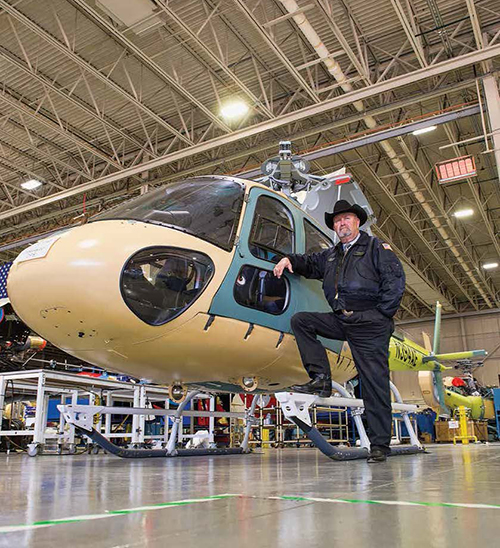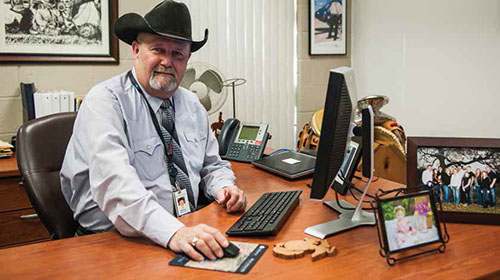
Sammy Pence - Vice President of Commercial Programs and MRO AIRBUS HELICOPTERS


If it weren’t for the trees and the water towers, and for a small hill about five miles to the east, you could see the tall buildings of Dallas. From this vantage point, Sammy Pence hangs his hat (literally) at work at Airbus Helicopters’ U.S. headquarters at Municipal Airport in Grand Prairie, TX.
For the past 15 years, this one-time steer wrestler has been a key player — and arguably an indispensable one — in Airbus Helicopters’ success as the leading supplier of helicopters to law enforcement, air medical, tourist and VIP markets. He also played a pivotal role in American Eurocopter (as Airbus Helicopters was known until this year) winning its first big U.S. defense contract for the manufactuer of the Army’s new UH-72A Lakota light utility chopper.
Pence is a large, gregarious man. His cowboy boots and his big black cowboy hat make him an imposing and somewhat incongruent figure as he walks corporate hallways where one would expect to find suited-up MBAs and earnestly serious engineers. Don’t be fooled by the hat, the boots, the western-cut shirts, the huge silver buckle on his hand-tooled belt or his down-home Texas drawl. Pence might be an authentic Texas cowboy, but he’s no hayseed when it comes to managing one of the nation’s largest helicopter repair and assembly operations.
“I’m in sort of a buffer or filter position here. There’s just as much barnyard material flowing up to me from the shop floors as there is corporate barnyard material flowing down from the executive offices up front,” says Pence, using his favorite term for the row of offices across the front of the administration building where most of Airbus Helicopters’ other senior executives work.
“Part of my job is listen to all that from both sides and translate it, filter out the unnecessary stuff, and pass on what’s important in terms the other side can understand,” he says.
It’s a job for which Pence seems to have been born.
Grand Prairie today is a sprawling, mostly industrial and lower-middle class suburb of 175,000 people. Fifty-nine years ago, when then-two-year-old Pence moved there with his family from Colorado, it was much smaller and very different place. There was Naval Air Station Dallas and the Vought Aerospace plant on the east side of town. Workers (including his father) built Navy fighter jets and Navy airmen practiced flying, but not much else happened in Grand Prairie.
“When I was growing up, this place was a cotton field,” he recalls about the airport. “My family was all in agriculture.”
After high school, he spent seven years in the Marines and learned to fix and maintain Sikorsky CH-53 Sea Stallions. In 1979, Pence came home and found a job turning wrenches at the Grand Prairie plant then run by the U.S. division of Aerospatiale. He studied agriculture at a local community college at night but never earned a degree.

Cowboy up
After 13 years, just as Aerospatiale was about to merge with Germany’s MBB to form Eurocopter, Pence decided to follow his heart. He quit to become a full-time cowboy.
“I cowboyed for seven years,” he says. “I broke horses. I mended fences. I worked in a saddle shop. And I did a little bit of rodeoing.”
Even though it made him an unusually old rookie, an almost 40-year-old Pence joined the Pro Rodeo circuit as a steer wrestler. Steer wrestling or “bulldogging” (as it is also known) requires a cowboy to jump off a perfectly good horse that is running at full speed. The cowboy’s goal is to land across the shoulders of a fleeing steer. If the cowboy lands successfully (which means not hitting the dirt face first or impaling himself on the steer’s pointy horns), the cowboy digs his heels into the dirt and “throws” the slowing beast to the ground by twisting its horns and neck.
“I never won any money at it, but I had fun,” says Pence.
Back to birds
Despite his rodeo days, Pence never quite left the helicopter business. He returned to American Eurocopter three times as a contractor hired to write maintenance manuals.
“They brought in some technical writers for those projects, but they couldn’t translate ‘Fren-glish,” he says, referring to the sometimes-odd English renderings of French words, phrases and idioms. These were an inherent byproduct of being an American unit of a company that designs all of and makes most of its helicopters at Marignane in the south of France.
“I had kinda learned to understand what they meant, but we couldn’t use those terms in the manuals our North American customers would be using,” he says. “There’s no way their mechanics would have understood some of those things. Some were pretty funny. My favorite was a set of instructions about cleaning a rotor hub. It said, ‘Offer up the hub and wipe with white spirits.’ I knew exactly what that meant: ‘position the hub and clean with alcohol’ — but it sounded like we were giving instructions on how to hold a séance.”
Pence says that by 1999 he was too old to continue on the rodeo circuit and was running low on money, so he returned to American Eurocopter. “This being an executive was certainly not on my career path,” he says while shaking his head.
Pence thought he’d spend the rest of his life turning wrenches happily. He had earned high marks before he left Aerospatiale in 1991 by working in the customer service department and coordinating the power-by-the-hour and leased helicopter maintenance programs. His new bosses quickly involved him in helping write bid proposals in response to requests for proposals from government agencies and large corporations looking to place large orders for helicopters.
Pence’s technical expertise and ability to communicate plainly and directly were key factors in Eurocopter winning contracts to supply helicopters to the Los Angeles Police Department, the Los Angeles County Sheriff’s Department, the California Highway Patrol and the Texas Department of Public Safety. Within a three-year period, Eurocopter became the industry sales leader in providing law enforcement and air medical helicopters to government agencies.
“We won because we had the best product on the market. And we still do,” he says. “I just helped explain why that was so.”
This won him the attention of Serge Panbiere, American Eurocopter’s chief operating officer at the time. Pence was promoted to director of helicopter completions in 2002. In 2003, new American Eurocopter CEO Marc Paganini gave Pence additional responsibility for all of the company’s MRO work.
“Serge and Marc saw something about me that they liked,” says Pence. “I guess they saw that I worked pretty hard, that I knew what I was doing and knew how to communicate. And I think they saw some leadership ability in me. I owe the Marines for that. The Marines do a good job of teaching leadership and I guess some of that took with me.”
A long and Dusty Trail
That doesn’t mean that going from shop technician to cowboy, to technical writer, to manager, and finally to senior executive has been an easy road.
Pence has, at times, struggled to retain good mechanics — many of who, like him, have other interests outside helicopters and who don’t like to linger too long in any one job or place. Many of his best workers took offers to work as government contractors maintaining military helicopters in places like Iraq and Afghanistan. (That problem now has eased with reduced U.S. involvement in those conflicts. In fact, the current availability of seasoned mechanics who gained experience in Iraq an Afghanistan is easing the impact of the retirements of nearly all of Eurocopter’s Vietnam-era mechanics.)
For Pence, being the primary filter between mechanics and assemblers on one side and senior management both in Grand Prairie and in Europe has also been trying and stressful. Twice Pence has found himself managing American Eurocopter’s engineering department despite having never studied engineering.
“Yeah, I was a mechanic overseeing engineers,” says Pence with a laugh. “Mechanics and engineers are very different in how they look at problems. Let’s just say I believe in the KISS (‘keep it simple, stupid’) principle.”
In 2005, Pence was promoted to vice president of commercial programs and MRO. Last year he was given additional responsibility for logistics and facilities.
His broad portfolio has him traveling frequently between Grand Prairie and Columbus, MS (site of Airbus Helicopters’ North American assembly and flight test center), talking on the phone or via video conference for hours with Airbus honchos in France, working on budgets and shuffling lots of paperwork. None of that keeps him from spending time on the shop floors with his mechanics and technicians.
“For a while after I got this job, mechanics would tell me all the time that before I got the job they didn’t see their vice presidents but maybe once a year, if that,” he says. “I don’t have a set plan, but I suppose I spend an hour or two in each of my shops every week, on average. “
Pence has rejected all opportunities to move to the company’s executive offices so that he can stay close to his team.
“I don’t want to be distant from my people,” he says. “I’ve always tried to treat my mechanics the way I wanted to be treated by my executives when I was a mechanic. I want to talk with my people whether it’s about their work, problems they’re having, projects we’re involved in, their families, or whatever.”
Pence relies heavily on his administrative assistant and his team of direct reports, most of who, like him, began their careers on the shop floor. They meet briefly each morning to deliver daily status reports and address pressing issues of the day.
“I don’t micro-manage my people,” he says. “I give all my direct reports authority to make decisions. I’m here to go over issues with them, to discuss solutions, to provide any ideas I have or guidance they want from me. But my job is to make it clear to them what the company’s goals and needs are and how we want things done so that they then can make decisions.”
When it comes to hiring and promoting managers on his team, Pence says he has only one rule, but it’s inviolate: “Don’t lie to me.” He expects the same level of honesty from those who work for him.
“I think my real strength is I’m honest,” he says. “If I’m asked a question, I’ll give you a straight answer.” He adds mid-level managers too often tell senior management “what they want to hear, not what they need to hear.”
“I don’t play games. I don’t have any type of agenda. I’ve only ever had one real goal here and that’s for Eurocopter — now Airbus Helicopters — to be the best helicopter manufacturer it can be.”
Now almost 61, Pence says he expects to retire in a couple of years to his 30-acre, 10-cow ranch near the tiny town of Coyote Flats, 40 miles southwest of Grand Prairie.
“It’s time to let the next generation run things, to make their mark,” he says. “We’ve trained a lot of these folks. It’s about time we let them run this place.”
